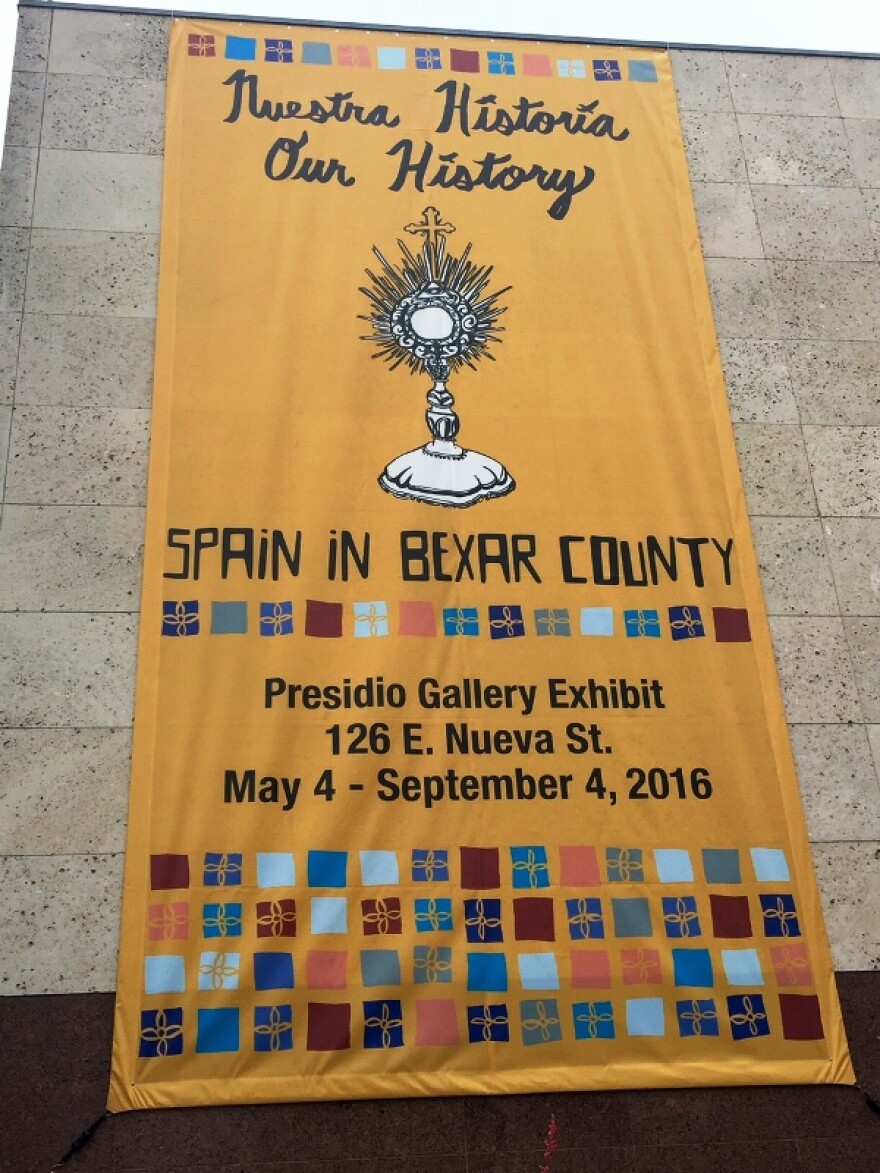In the 17th and 18th centuries the Spanish sought to extend their colonies by settling in what is now Bexar County. An exhibit opening this week in San Antonio’s former Federal Reserve Building helps tell the story of how the Spanish first came to the area.

Outside the exhibit, a man in native dress carries a pottery bowl with burning sage through the crowd of two dozen, fanning the smoke towards each person as he passes. His Native American blessing was for the visitors and the new exhibit itself--Nuestra Historia--Our History. A young woman read the blessing.
"Oh, spirit of the east, land of the rising sun..."

The Native Americans conducting the ritual are members of the Tehuan band of Mission Indians, who lived in Texas before the Spanish arrived. A young man begins drumming, and Epifanio Hernandez sings what he calls The Warrior Song.
The ceremony concludes, the ribbon is cut and people filter through a small theater where a short film explains the importance of the artifacts on display.
"...and the 1717 Rebolledo Letter, laying out a plan to establish a settlement along the San Antonio River..."
That Rebolledo Letter was literally what got San Antonio started. Betty Bueche is the director of Bexar Heritage.
"Yes, it's the decision document. And it was written before the founding of Mission Valero, which has come to be known as the Alamo. So before anything here that the Spaniards established, this report was written making the recommendation that it be established."
Juan Manuel Rebolledo's letter was sent to the Marquis in Mexico, was approved, and the colonizing in this part of Texas began. The process itself was what the Spanish did wherever they went. As Bueche explains, it was one part government, one part commerce and one part religion.
"When Spain went on expeditions around the world, they were required by law to always make an effort to Christianize any native peoples they came across. So it was not possible for just soldiers, or just entrepreneurs, or just settlers to branch out into the new world without also taking with them priests."
The Nuestra Historia exhibit is a collection of maps, letters, coins, carvings, religious and archeological artifacts. Their existence is largely due to the Spanish preoccupation with documenting.
"The Spanish were masters of bureaucracy. They documented everything!"
Dr. Sarah Gould curated this exhibit.
"A lot of the archeological artifacts in the exhibit are here because I wanted the people to know it wasn't just the Spanish here."
I noted how surprised I was at the color of maps, documents and other items. Gould responded enthusiastically.
"Yes, 18th century Spain was full of bright colors, believe it or not. The San Antonio Missions were originally painted on the outside."
In contrast to the mostly muted earth tones you see today, the facades of the Spanish missions were painted with wildly colorful geometric frescoes.
"It's really neat, isn't it? You have to remember that the Spanish were heavily influenced by the Moors and when you think of Moorish tile, Moorish design, they have been heavily influenced by that. The indigenous people have their own artistic conditions, which include using natural pigments and paints and that sort of thing, so they're no strangers to bright colors either. So we've got these two cultures together and you're just bound to get really fantastic artistic expression.
The Nuestra Historia exhibit includes paintings of the frescoes at Mission Concepcion. Here's Betty Bueche.
"The water color documentation by Ernst Schuchard shows us that he captured the remaining frescoes that existed before they were destroyed over time."
Bueche wondered at how it might have been for travelers to come across the missions by accident. "It would've been extraordinary to literally be in the middle of nowhere, and then come upon a building of that size."

County Judge Nelson Wolff was at the dedication, as he helped get the old Federal Reserve building remodeled as a space to display the artifacts.
"It's very meaningful. And I think you have that same feeling when you look at some of these documents that you can almost transport yourself back 300 years when that was drawn or when that was written."
Although the Spanish established missions around the world Bexar County is the only place where they built five, which are now a World Heritage site. The Nuestra Historia exhibit documents the planning and events that went into that. Nuestra Historia is open to the public until Sept. 4.
Find more on Nuestra Historia here.










